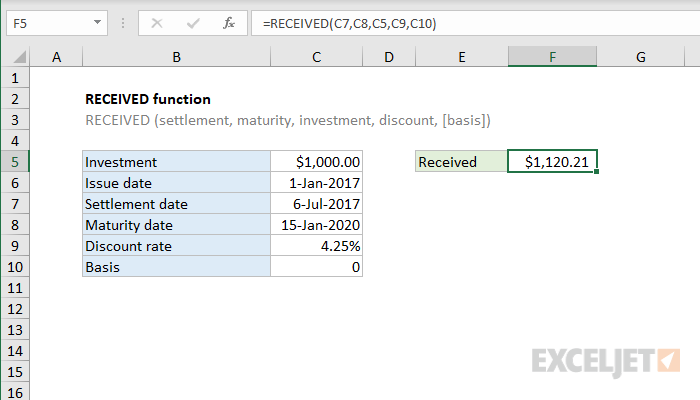Purpose
Return value
Syntax
=RECEIVED(settlement,maturity,investment,discount,[basis])- settlement - Settlement date of the security.
- maturity - Maturity date of the security.
- investment - Amount investment in the security.
- discount - The security's discount rate.
- basis - [optional] Day count basis (see below, default =0).
Using the RECEIVED function
The RECEIVED function returns the amount received at maturity for a fully invested security. A fully invested security does not pay periodic interest before maturity. The interest income is the difference between the redemption value of the security and the original investment.
Example
In the example shown, we want to find the amount received at maturity for a bond with an initial investment of $1000 and a discount rate of 4.25%. The settlement date is 6-Jul-2017 and the maturity date is 15-Jan-2020. There are no periodic interest payments, and the day count basis is US (NASD) 30/360. The formula in F5 is:
=RECEIVED(C7,C8,C5,C9,C10)
With these inputs, the RECEIVED function returns $1,120.21 , with currency number format applied.
Entering dates
In Excel, dates are serial numbers. Generally, the best way to enter valid dates is to use cell references, as shown in the example. To enter valid dates directly inside a function, you can use the DATE function. To illustrate, the formula below has all values hardcoded, and the DATE function is used to supply each of the two required dates:
=RECEIVED(DATE(2017,7,6),DATE(2020,1,15),1000,0.0425,0)
Basis
The basis argument controls how days are counted. The RECEIVED function allows 5 options (0-4) and defaults to zero, which specifies US 30/360 basis. This article on Wikipedia provides a detailed explanation of available conventions.
| Basis | Day count |
|---|---|
| 0 or omitted | US (NASD) 30/360 |
| 1 | Actual/actual |
| 2 | Actual/360 |
| 3 | Actual/365 |
| 4 | European 30/360 |
Notes
- In Excel, dates are serial numbers.
- All dates, and basis, are truncated to integers.
- If dates are invalid (i.e. not recognized dates) RECEIVED returns #VALUE!
- RECEIVED returns #NUM when:
- settlement >= maturity
- investment <= 0 or rate <= 0
- Basis is out-of-range









